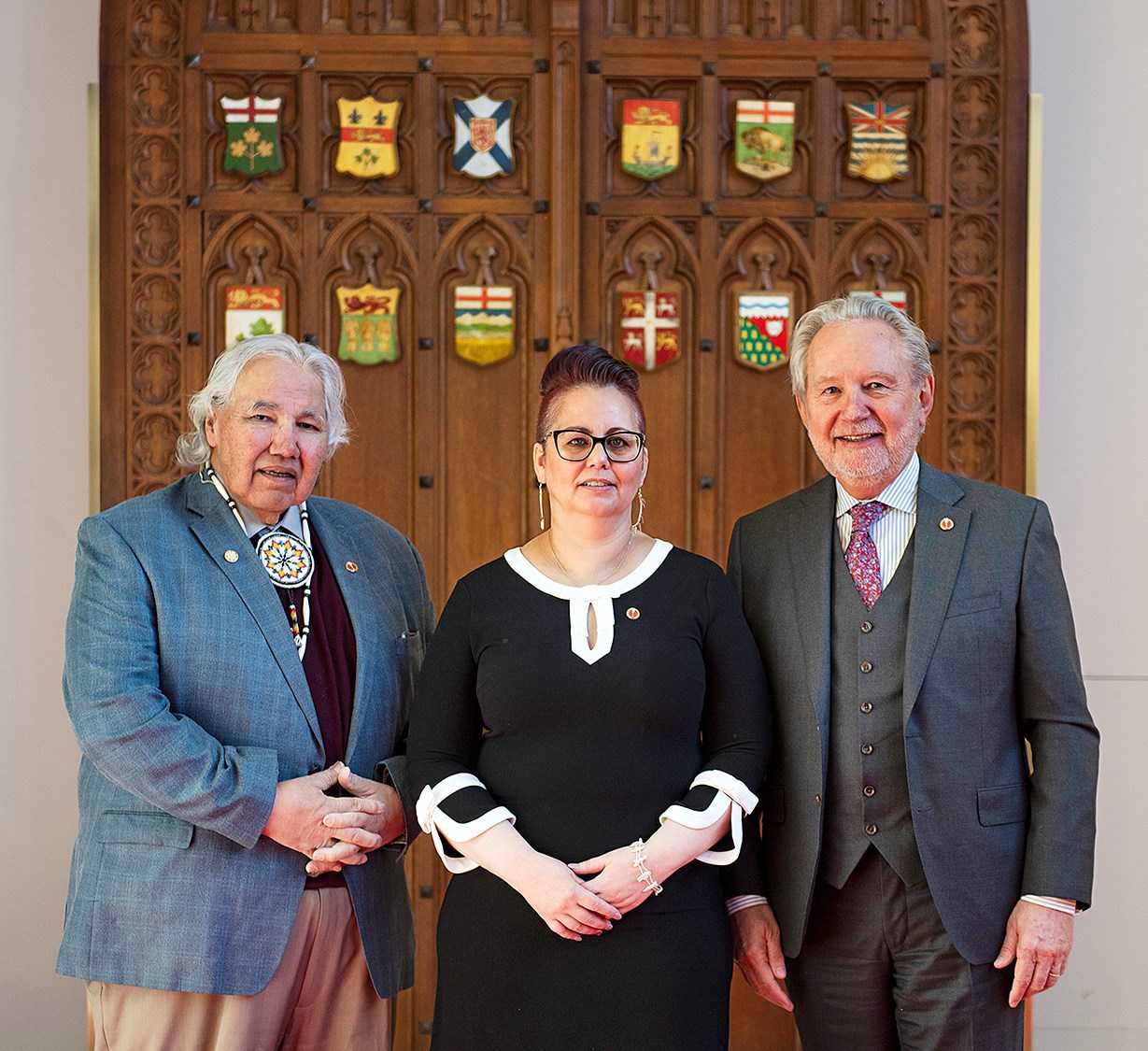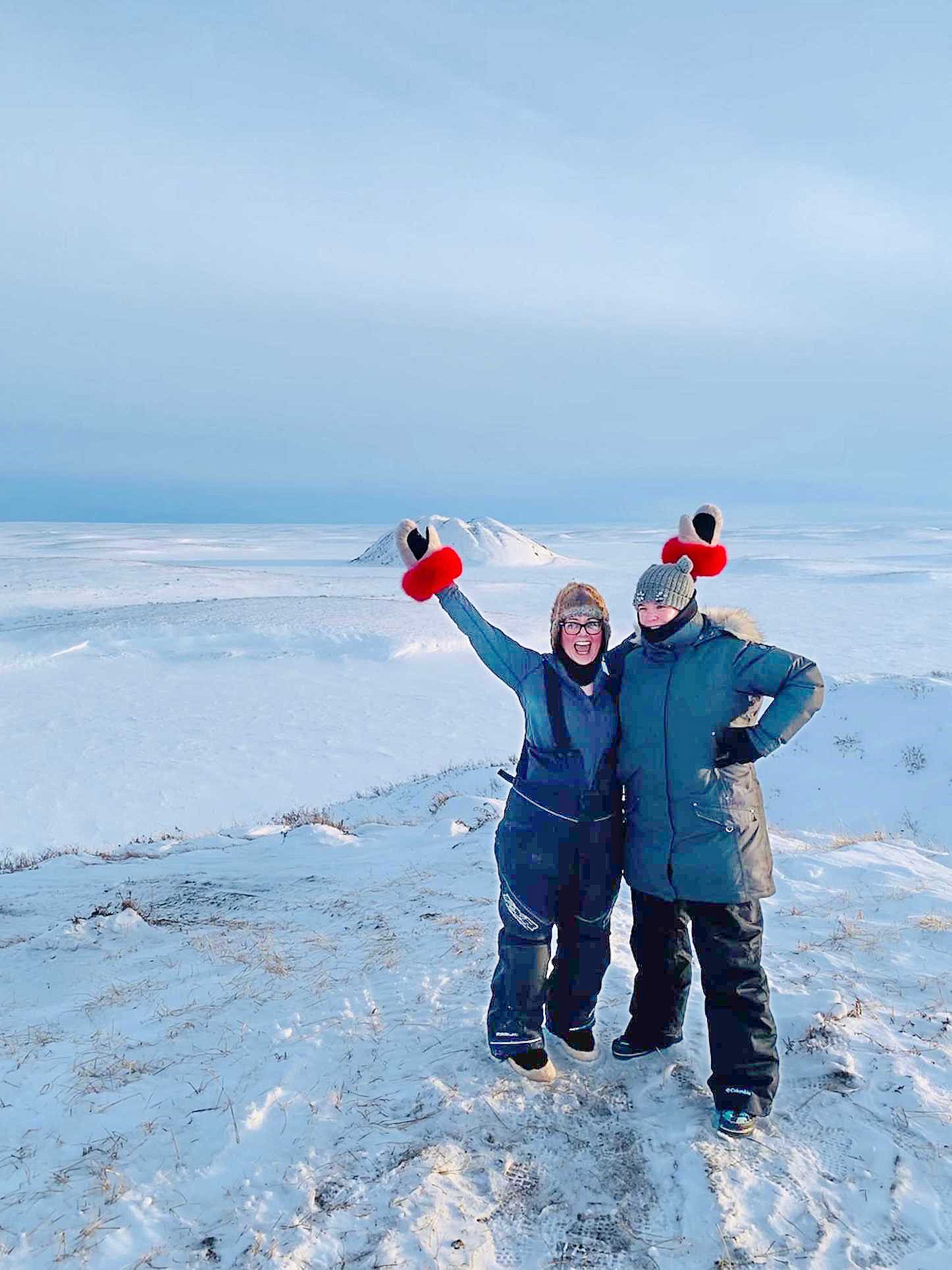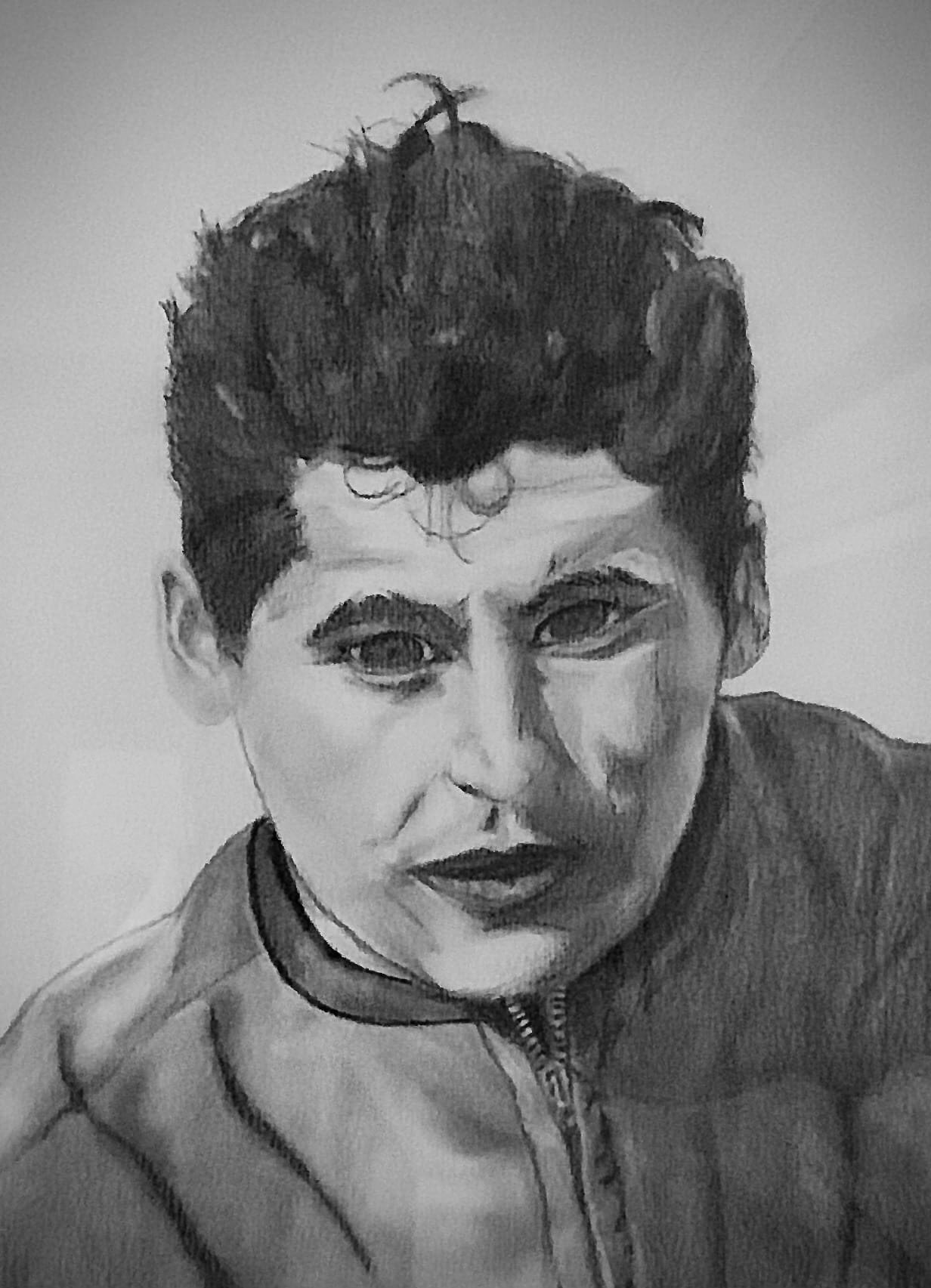Meet Senator Dawn Anderson

For many years, Senator Dawn Anderson’s mother was named W3-779. It was part of a decades-long federal policy that erased Inuit names and replaced them with “Eskimo identification” numbers.
In traditional Inuit culture, the process of naming a newborn child is deeply meaningful. An elder often gifts a family member’s name as a way of carrying on that person’s legacy and connecting the child to their ancestors. Although the federal government scrapped “Eskimo identification” decades ago, the colonial naming system still complicates names for many elderly Inuit, like Senator Anderson’s mother.
In this interview with SenCAplus, Senator Anderson describes her strong connection to her family’s Inuit names and how her hometown community of Tuktoyaktuk inspires her work in the Senate today.
Who inspired you to get involved in public life?
My biggest inspiration for public life would be my five children. I actually applied to be a senator at the request of my daughter who would have been eight or nine years old at the time.
What is one thing most Canadians might not know about you?
I write poetry and I do charcoal drawings. There’s a lot of artists on my mom’s side of the family. Her three brothers — Bill, Eli and Joe Nasogaluak — are quite well renowned and they do all kinds of mediums. Artistic abilities appear to run in our family.
What do you think are the biggest public policy issues facing Canada today?
I think one of the biggest public policy issues is meaningful reconciliation and relationship-building with Indigenous peoples. With the Truth and Reconciliation Commission’s recommendations and the Royal Commission on Aboriginal Peoples report that dates back almost 30 years, there needs to be a meaningful way forward. Not just talking about it, but concrete actions.
Why should more Canadians care about what happens in the Senate?
Because we represent regions and particularly the interests of minorities and vulnerable populations. We come from increasingly diverse backgrounds. There are now 10 Indigenous senators, which is not an awful lot in the Senate, but we work hard to ensure that Indigenous peoples’ perspectives are considered in the development of federal legislation.
Sometimes southern legislation has a negative impact on communities in the North. An example is the medical assistance in dying bill. I could not support this bill when, in the Northwest Territories, our right to live is already compromised. I can’t support the right to die until we have the same standard of living in the North as they do in the South, such as housing, food and health care.
What legislative work are you most proud of participating in so far?
I take pride in everything that I do, so it’s hard for me to pick one thing. What I would say is important to me are the partnerships. If I know there’s a bill that impacts the Northwest Territories, I’ll seek out different groups to speak to them about how a bill may affect them. To me, it’s the behind-the-scenes work that’s the most important.
How did your previous work as a public servant in community justice and policing prepare you for the Senate?
My last job was to advocate on behalf of those who were disenfranchised, minorities and those who struggled with the day-to-day. I think what probably prepared me the most is the ability to listen to those who often aren’t listened to.
What is a hidden gem in your region that more Canadians need to know about?
I would say our whole territory is a hidden gem. I don’t think people understand Northern Canada because it seems that when many Canadians think of the North, they just see a snow-covered barren landscape with no trees, few people. That’s not the case. I think the territory has a lot to offer. It’s beautiful and very diverse. We have 11 official languages, which I don’t think people are aware of.




I submitted an expense claim and they asked why I rented a truck and not a car. I was shocked. The majority of roads here are gravel, except for in Yellowknife. We have the Tuktoyaktuk Highway and it’s a two-and-a-half-hour drive, but it’s all gravel and it’s subject to the weather elements, including storms that blow for days and close off the road. So it’s those little nuances that, I think, are really important to understanding some of the challenges — but also some of the positives — that we have in the North.
Can you name a song that always makes you smile and tell us why?
Arnaq by Elisapie, an Inuk songwriter. I don’t fully understand the words because I don’t speak Inuktitut, but I recognize some words and it just speaks to me. It’s a very powerful song about women. It reminds me of my mother, who passed away about three years ago.
Do you have any hobbies?
I purchase old press photos and House of Commons books from the late 1800s, early 1900s from eBay and I research the stories behind them. I think it’s important not to forget the past so we don’t repeat those same mistakes. My aunt was in residential school in Yellowknife at Stringer Hall and I found one of her paintings on eBay from an art teacher who had kept it. It was quite shocking to see it on there.
It’s as if you discovered a piece of family history.
I did. It was signed with her maiden name, Nasogaluak. My mom was born with five Inuk names — no English name and no last name. In the 1930s, the government decided Indigenous people in the North needed another identifier, so they started identifying people by number. My mom’s number was W3-779. By 1966, the government decided people should have names so they instituted Project Surname. My mother became Sarah Martha Nasogaluak. When she was about 80 years old, she needed picture ID, so we went to the government office, but it was complicated because her birth certificate only had her Inuk names. Indigenous people here in the North still have issues getting adequate ID when their birth certificates list their Inuk names, but Canada changed those names.
Why are you proud to be Inuvialuk?
For me, Inuvialuk means being part of a family, community, culture and language. It’s not singular, it’s a collective. Back home, you weren’t raised by just your parents, you were raised by a community of people. You learned from everybody. Inuvialuk is that sense of taking care of each other, looking out for one another. That’s important to me, to bring that with me wherever I go. It’s definitely where I’m rooted and it’s what inspires me the most.
Related articles
Tags
Committee news
Meet Senator Dawn Anderson

For many years, Senator Dawn Anderson’s mother was named W3-779. It was part of a decades-long federal policy that erased Inuit names and replaced them with “Eskimo identification” numbers.
In traditional Inuit culture, the process of naming a newborn child is deeply meaningful. An elder often gifts a family member’s name as a way of carrying on that person’s legacy and connecting the child to their ancestors. Although the federal government scrapped “Eskimo identification” decades ago, the colonial naming system still complicates names for many elderly Inuit, like Senator Anderson’s mother.
In this interview with SenCAplus, Senator Anderson describes her strong connection to her family’s Inuit names and how her hometown community of Tuktoyaktuk inspires her work in the Senate today.
Who inspired you to get involved in public life?
My biggest inspiration for public life would be my five children. I actually applied to be a senator at the request of my daughter who would have been eight or nine years old at the time.
What is one thing most Canadians might not know about you?
I write poetry and I do charcoal drawings. There’s a lot of artists on my mom’s side of the family. Her three brothers — Bill, Eli and Joe Nasogaluak — are quite well renowned and they do all kinds of mediums. Artistic abilities appear to run in our family.
What do you think are the biggest public policy issues facing Canada today?
I think one of the biggest public policy issues is meaningful reconciliation and relationship-building with Indigenous peoples. With the Truth and Reconciliation Commission’s recommendations and the Royal Commission on Aboriginal Peoples report that dates back almost 30 years, there needs to be a meaningful way forward. Not just talking about it, but concrete actions.
Why should more Canadians care about what happens in the Senate?
Because we represent regions and particularly the interests of minorities and vulnerable populations. We come from increasingly diverse backgrounds. There are now 10 Indigenous senators, which is not an awful lot in the Senate, but we work hard to ensure that Indigenous peoples’ perspectives are considered in the development of federal legislation.
Sometimes southern legislation has a negative impact on communities in the North. An example is the medical assistance in dying bill. I could not support this bill when, in the Northwest Territories, our right to live is already compromised. I can’t support the right to die until we have the same standard of living in the North as they do in the South, such as housing, food and health care.
What legislative work are you most proud of participating in so far?
I take pride in everything that I do, so it’s hard for me to pick one thing. What I would say is important to me are the partnerships. If I know there’s a bill that impacts the Northwest Territories, I’ll seek out different groups to speak to them about how a bill may affect them. To me, it’s the behind-the-scenes work that’s the most important.
How did your previous work as a public servant in community justice and policing prepare you for the Senate?
My last job was to advocate on behalf of those who were disenfranchised, minorities and those who struggled with the day-to-day. I think what probably prepared me the most is the ability to listen to those who often aren’t listened to.
What is a hidden gem in your region that more Canadians need to know about?
I would say our whole territory is a hidden gem. I don’t think people understand Northern Canada because it seems that when many Canadians think of the North, they just see a snow-covered barren landscape with no trees, few people. That’s not the case. I think the territory has a lot to offer. It’s beautiful and very diverse. We have 11 official languages, which I don’t think people are aware of.




I submitted an expense claim and they asked why I rented a truck and not a car. I was shocked. The majority of roads here are gravel, except for in Yellowknife. We have the Tuktoyaktuk Highway and it’s a two-and-a-half-hour drive, but it’s all gravel and it’s subject to the weather elements, including storms that blow for days and close off the road. So it’s those little nuances that, I think, are really important to understanding some of the challenges — but also some of the positives — that we have in the North.
Can you name a song that always makes you smile and tell us why?
Arnaq by Elisapie, an Inuk songwriter. I don’t fully understand the words because I don’t speak Inuktitut, but I recognize some words and it just speaks to me. It’s a very powerful song about women. It reminds me of my mother, who passed away about three years ago.
Do you have any hobbies?
I purchase old press photos and House of Commons books from the late 1800s, early 1900s from eBay and I research the stories behind them. I think it’s important not to forget the past so we don’t repeat those same mistakes. My aunt was in residential school in Yellowknife at Stringer Hall and I found one of her paintings on eBay from an art teacher who had kept it. It was quite shocking to see it on there.
It’s as if you discovered a piece of family history.
I did. It was signed with her maiden name, Nasogaluak. My mom was born with five Inuk names — no English name and no last name. In the 1930s, the government decided Indigenous people in the North needed another identifier, so they started identifying people by number. My mom’s number was W3-779. By 1966, the government decided people should have names so they instituted Project Surname. My mother became Sarah Martha Nasogaluak. When she was about 80 years old, she needed picture ID, so we went to the government office, but it was complicated because her birth certificate only had her Inuk names. Indigenous people here in the North still have issues getting adequate ID when their birth certificates list their Inuk names, but Canada changed those names.
Why are you proud to be Inuvialuk?
For me, Inuvialuk means being part of a family, community, culture and language. It’s not singular, it’s a collective. Back home, you weren’t raised by just your parents, you were raised by a community of people. You learned from everybody. Inuvialuk is that sense of taking care of each other, looking out for one another. That’s important to me, to bring that with me wherever I go. It’s definitely where I’m rooted and it’s what inspires me the most.


